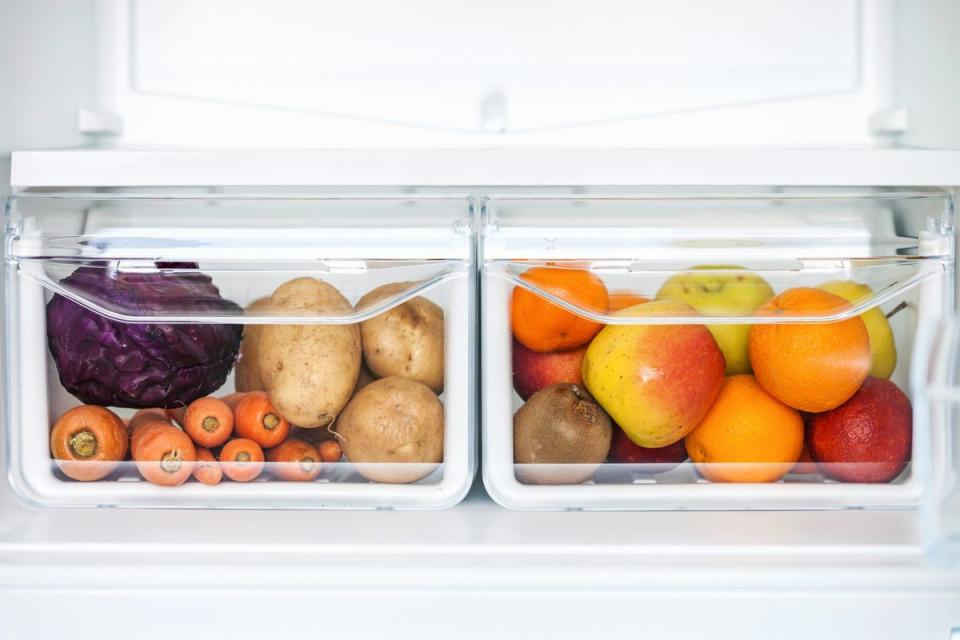10 Foods You Should Never Store In The Refrigerator
TABLE OF CONTENTS
On This Page
Tomatoes
Onions
Potatoes
Oil
Bananas
Coffee
Honey
Bread
Avocados
Garlic
When it comes to fruits, vegetables, and other grocery items, it can be our first instinct to store everything in the refrigerator to try to keep them fresh for as long as possible. While there are some foods you should always refrigerate, such as carrots, berries, and most cheeses, it's not a one-size-fits-all rule. Turns out, the cold temperature and humidity of the fridge can have a negative effect on some fresh produce and grocery products. Your pantry shelf might just provide the perfect atmosphere for your groceries to thrive, so don't always be tempted to open the refrigerator door.
Keep your food fresh and delicious, inside the fridge and out. Here are the top 10 things you don't need to refrigerate, even if you think you need to.
Tomatoes
Your haul of fresh tomatoes belongs on the counter, not in the refrigerator. The cold, humid atmosphere inside the fridge can affect the texture of your tomatoes before you have a chance to use them. Just make sure to keep them out of direct sunlight. Cherry tomatoes are the only variety that tends to stand up to time in the fridge without turning mushy or mealy too quickly.
Onions
Most types of onions (like yellow, white, and sweet) do best when stored at room temperature, preferably in your pantry out of direct sunlight and away from residual heat from your stovetop or oven. It also does best to store these on their own, instead of nestled up against other vegetables, including potatoes, or fruits. If the onions start to turn, they can release a bad odor or residue. After an onion is cut, the remaining bits can be stored in a baggie or airtight container in the fridge.

Getty Images/MurzikNata
Potatoes
There is absolutely no reason to store potatoes in the refrigerator. Cool and dry is the way to go, so your pantry is the best place for storing any potatoes, preferably in a basket or paper bag. Cold temperatures tend to affect potatoes' texture by breaking down the starches, turning them gritty or unintentionally sweet.
Oil
It should go without saying. Do this once, and you won't likely do it again. Oils like olive oil, avocado oil, or vegetable oil thicken or solidify in cold temperatures, which isn't quite ideal when it comes time to start cooking. Store them in a cool, dark place away from light.
Bananas
For a banana to taste its best, it should be kept at room temperature, especially if it requires more ripening. Once bananas start to turn brown, use immediately (banana bread, anyone?) or freeze for later. Be aware that bananas can cause nearby fruits to ripen quicker, so organize them accordingly. Perhaps, not next to the avocados?
Coffee
Coffee needs to be kept away from any humidity, lest it be subject to molding or ruining the flavor before you've had a chance to brew it all. Keep in an airtight container on the counter or in the pantry. There has been some debate about keeping coffee beans in the freezer before grinding to enhance flavor, but it only works if the beans are sealed correctly in an airtight container.
Honey
Cold temperatures can cause honey to crystallize more quickly than when stored in a dark, cool place like your pantry. Keep in mind that, over time, honey will always crystallize eventually.
Bread
While the refrigerator has been said to help keep bread from molding, the humidity of the fridge draws out the moisture from the bread, leaving you with bland, dry slices. You don't want your hard work on a homemade loaf to go to waste. Instead, store in the freezer to thaw and toast whenever desired.

Getty Images
Avocados
The refrigerator will slow avocados in the ripening process, so unless you're stacked with too many avocados for your weekly use, keep them out at room temperature. The cold temperature also hardens the texture of a ripe avocado, which might not be ideal for some when it comes to mealtime. Once cut open, store any open-faced halves in a baggie or container in the fridge.
Garlic
We're not talking about your pre-minced garlic from the grocery store. If you're springing to peel and cut your own, you'll likely pick up a head of garlic instead. This head (or knob) is best stored along with the onions and potatoes in your cool, dark pantry until you've opened it up. Once cut, store in the fridge.
Don't let any of your food go to waste with these storage tips.
